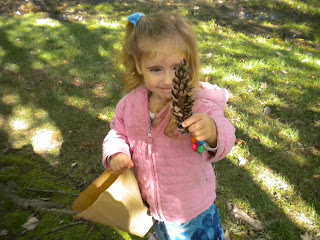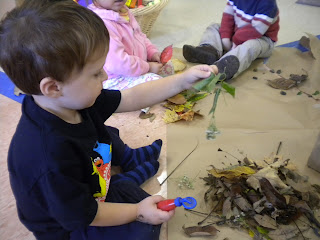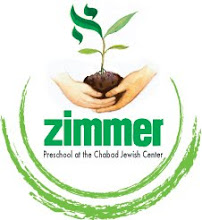· Math – Children will use critical thinking while practicing sharing and problem solving. They will also practice counting, number recognition, matching and one-to-one correspondence.
· Fine motor – Children will strengthen fine motor skills by working with small pieces of paper.
Attention getter:
THE BOX intro: Box, box, what's in the box? It could be something really big or something really small. It could be a toy or it could be a ball. It could be anything at all. Do you want to see what's in the box? OK, on the count of three. 1 2 3 All eyes on me!
Morah takes out a printout of a pumpkin pie:
Morah: WOW! Look at this yummy pumpkin pie. What shape is the pie? What colors do you see on the pie? What kind of pie do you think this is? Have you ever had pumpkin pie? What did it taste like? Oh, I bet this pie is soooo yummy and delicious. I bet it will taste sweet and creamy; I just can't wait to eat it. Do you have a pie?
Kids: "No, I don't have a pie :(" "I want a pie" "Can I have a pie?"
Morah: Oh, you don't have a pie:(?! I want you to have some pie too but I only have one pie. What can we do?.....
Kids: "You can rip it" "You can cut it" "You can share the pie with us!"
Morah: We can share this pie :)?! Oh what a great idea!!! We can cut this pie and everyone can have a piece. Would having a piece of this pie make you feel happy?
Kids: "YES!" "I want some pie" "Can I have some too?" “I like pie” "Let's share the pie" "YAY! We're going to share the pie!"
Morah: You know what? I think sharing this pie with you would make ME happy too!!!! I think eating this pie all by myself would not be as fun but sharing it with you sounds like SO MUCH FUN!!! But wait, how can we find out how many pieces of pie we need?
Kids: "We can count" "We can count how many friends we have in class"
Morah: Ok let's count our friends. Can you help me? 1 2 3 4 5 6 7 we have 7 friends
Kids: "And you Morah" "Don't forget Morah!" "We have 8 friends" "We need to cut 8 pieces of pie"
Morah: OK so now we know we need to cut this pie into 8 pieces. First let’s use this marker to draw the lines and divide the pie into 8 equal, same size pieces.
Morah draws a line down the middle of the pie.
How many pieces do you see? Let's count. 1 2 Is that enough for everyone?
Kids: "NO" "Only two people can share this pie" “We need more"
Morah draws a line across the pie.
How about now? How many pieces do you see? Let's count. 1 2 3 4 Is that enough?
Kids: "NO" "Let's draw another line"
Morah draws a line diagonally.
Let's count and see if this is enough. 1 2 3 4 5 6 Is that enough?
Kids: "NO" "Let’s keep going" "Draw more lines"
Morah draws another diagonal line
Morah: How about now? Lets count
Kids: 1 2 3 4 5 6 7 8 "That's enough" "We have 8" "Everyone can have a piece" "Let’s share the pie"
Morah: Great but before we cut it let's count the pieces again and number them just to make sure we have enough for everyone (children count while Morah numbers each piece of pie)
Morah cuts the pie, gives everyone a piece and we pretend to eat it. YUM!
Morah: Did you have fun sharing this pie? Me too!! I would not have this much fun if I ate this pie all by myslef. It's more fun to share! Let’s think of other things we can share.... What can you share?
Morah asks each child what else they can share and writes the response on their piece of pie.
Morah puts out the round cardboard and cut up paper on the table with children sitting around it.
Morah: I have this big round piece of cardboard. I wonder what we can do with it? Does this round cardboard remind you of something else that's also round?
Kids: "A wheel" "Pizza" "A pie like the pumpkin pie we shared"
Morah: Yes a wheel is round and a pizza is round too, you're right. OH yeah!!! You're right, this IS round just like the pumpkin pie we shared before.
Morah shows a picture of a whole pumpkin pie just like the one we previously shared.
Morah: Would you like to make this round cardboard into a big pumpkin pie?
Kids: "YES!" "Let's make a pumpkin pie" "Are we going to share it?"
Morah: Sure we can share it. It's more fun to share! OK so how do we make this look like a pumpkin pie?
Kids: "We can use this paper, it's the same color like the pie" "We need glue" "I want glue!!"
With Morah's help children study, discuss and plan the craft.
Morah: What colors do you see on the pie? What color is in the middle? What color do you see on the edge around the pie? Can you match the colored paper to the colors on the pie? OK, great so here's the plan. To make this cardboard look just like the pumpkin pie we will glue this color paper in the middle of the cardboard and this color around the edges. I'm going to get some glue.
Morah gets only one glue stick.
Morah: OH no friends, I only found one glue stick. I don't know what to do. How can we make the pie with only one glue stick.
Kids: "We can get more glue" "Look again" "We need more glue" "Give me the glue" "I want the glue" "OR we can share, let's share the glue"
Morah: OH what a great idea!!! We can share the glue just like we shared the pie. But wait a minute, how are we going to share the glue. We can't cut the glue stick like we did with the pie. How can we share the glue?
Kids: "I know!!!! We can take turns" "I want a turn" "I want a turn too" "When is it going to be my turn" "Can I go first?"
Morah: You're right!! We can take turns, taking turns is also a way that we can share something. So let's share this glue and everyone will have a turn.
Morah facilitates the sharing process as children take turns with the glue and then place the colored pieces of paper in appropriate places while looking at the printout of the pumpkin pie for reference and accuracy.
Kids: "We did it" "Wow look at our pumpkin pie" "It's so big" "Look just like the pie in the picture" "It looks the same!!!"
Morah: You're right this pie looks great, just like the one in the picture. Did you have fun making this pie?
Kids: "Yes" "Let's make another pie" "We can share the glue again"
Morah: That's right we shared the glue. If we did NOT share the glue we would not be able to make this pie. It's more fun to share!!!
Kids: "Yeah it's more fun to share" "We can share" "We shared!!!"
The process of counting and dividing the pie was repeated with this pie as well however this time we glued long strips of paper to make the separation of pieces instead of cutting the pie. We also wrote on each piece what we can share and we saved pieces of the pie for friends who were not in school on that day. We also repeated the whole pie sharing circle time box activity twice more on different days so that everyone in class had a chance to experience this lesson and thoughtfully add what they can share to our Thanksgiving Sharing Pie. Children really loved this lesson and imitated the process of counting, cutting and sharing the pie in the kitchen area during center time.







 "Open it!" "I don't know." "My daddy, he open a pumpkin and I see there is SEEDS inside!" "Can we open this pumpkin ?" "Can I open it?" "No the pumpkin is too hard." "We need a knife."
"Open it!" "I don't know." "My daddy, he open a pumpkin and I see there is SEEDS inside!" "Can we open this pumpkin ?" "Can I open it?" "No the pumpkin is too hard." "We need a knife." "YES!" "I want to see the seeds!" "We going to open the pumpkin!" "Be careful Morah." "The knife is sharp, you can get a boo boo." "I don't touch the knife, only Morah can touch the knife."
"YES!" "I want to see the seeds!" "We going to open the pumpkin!" "Be careful Morah." "The knife is sharp, you can get a boo boo." "I don't touch the knife, only Morah can touch the knife."


 "Is it empty?" "No there's some more." "I want to get it." "Can you help me?"
"Is it empty?" "No there's some more." "I want to get it." "Can you help me?"



 We looked high.............
We looked high.............
 "Wow, look at all the leaves on the ground." "I think I see a bug." "Hello bug, are you there?"
"Wow, look at all the leaves on the ground." "I think I see a bug." "Hello bug, are you there?"

 "I found some leaves on the grass, I'm going to put them in my bag so I can bring them to class."
"I found some leaves on the grass, I'm going to put them in my bag so I can bring them to class."

























